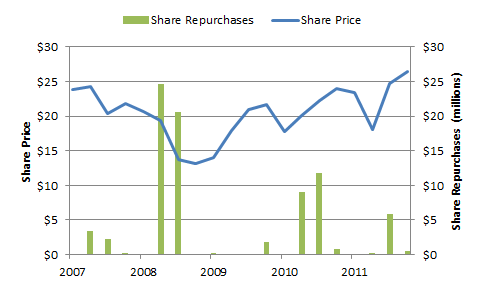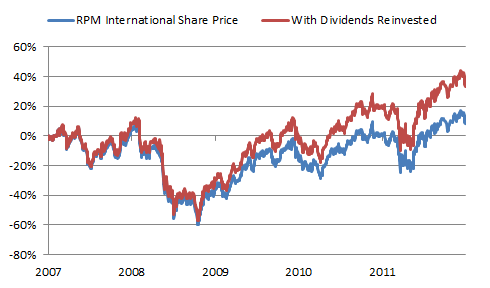What RPM International Does With Its Cash
In the quest to find great investments, most investors focus on earnings to gauge a company's financial strength. This is a good start, but earnings can be misleading and incomplete. To get a clearer understanding of a company's ability to earn money and reward you, the shareholder, it's often better to focus on cash flow. In this series, we tear apart a company's cash flow statement to see how much money is truly being earned, and more importantly, what management is doing with that cash.
Step on up, RPM International (NYS: RPM) .
The first step in analyzing cash flow is to look at net income. RPM International's net income over the last five years has been impressive:
2011 | 2010 | 2009 | 2008 | 2007 | |
|---|---|---|---|---|---|
Normalized Net Income | $196 million | $178 million | $178 million | $154 million | $199 million |
Source: S&P Capital IQ.
Next, we add back in a few non-cash expenses like the depreciation of assets, and adjust net income for changes in inventory, accounts receivable, and accounts payable -- changes in cash levels that reflect a company either paying its bills, or being paid by customers. This yields a figure called cash from operating activities -- the amount of cash a company generates from doing everyday business.
From there, we subtract capital expenditures, or the amount a company spends acquiring or fixing physical assets. This yields one version of a figure called free cash flow, or the true amount of cash a company has left over for its investors after doing business:
2011 | 2010 | 2009 | 2008 | 2007 | |
|---|---|---|---|---|---|
Free Cash Flow | $148 million | $175 million | $289 million | $128 million | $164 million |
Source: S&P Capital IQ.
Now we know how much cash RPM International is really pulling in each year. Next question: What is it doing with that cash?
There are two ways a company can use free cash flow to directly reward shareholders: dividends and share repurchases. Cash not returned to shareholders can be stashed in the bank, used to invest in other companies and assets, or to pay off debt.
Here's how much RPM International has returned to shareholders in recent years:
2011 | 2010 | 2009 | 2008 | 2007 | |
|---|---|---|---|---|---|
Dividends | $111 million | $108 million | $104 million | $99 million | $89 million |
Share Repurchases | $7 million | $20 million | $2 million | $45 million | $6 million |
Total Returned to Shareholders | $118 million | $128 million | $106 million | $145 million | $95 million |
Source: S&P Capital IQ.
As you can see, the company has repurchased a decent amount of its own stock. But combined with other rounds of share issuance, shares outstanding have actually increased:
2011 | 2010 | 2009 | 2008 | 2007 | |
|---|---|---|---|---|---|
Shares Outstanding (millions) | 128 | 127 | 127 | 125 | 120 |
Source: S&P Capital IQ.
Now, companies tend to be fairly poor at repurchasing their own shares, buying feverishly when shares are expensive and backing away when they're cheap. Does RPM International fall into this trap? Let's take a look:

Source: S&P Capital IQ.
RPM International's buybacks have been few and far between over the last five years, so this doesn't tell us much. Given reasonable valuations, these buybacks have likely been a decent deal for shareholders.
Finally, I like to look at how dividends have added to total shareholder returns:

Source: S&P Capital IQ.
Shares returned 8% over the last five years, which increases to 33% with dividends reinvested -- a nice to top off otherwise low performance.
To gauge how well a company is doing, keep an eye on the cash. How much a company earns is not as important as how much cash is actually coming in the door, and how much cash is coming in the door isn't as important as what management actually does with that cash. Remember, you, the shareholder, own the company. Are you happy with the way management has used RPM International's cash? Sound off in the comment section below.
Add RPM International to My Watchlist.
At the time thisarticle was published Fool contributor Morgan Housel doesn't own shares in any of the companies mentioned in this article. Follow him on Twitter @TMFHousel. The Motley Fool has a disclosure policy. We Fools may not all hold the same opinions, but we all believe that considering a diverse range of insights makes us better investors. Try any of our Foolish newsletter services free for 30 days.
Copyright © 1995 - 2012 The Motley Fool, LLC. All rights reserved. The Motley Fool has a disclosure policy.

